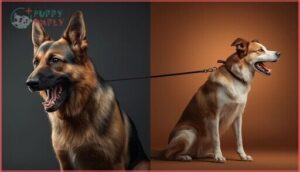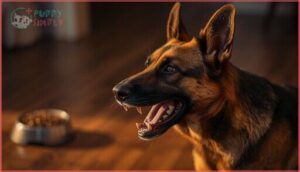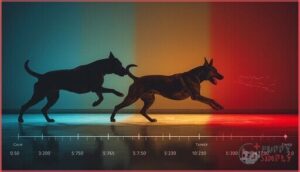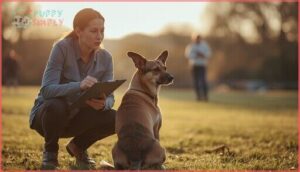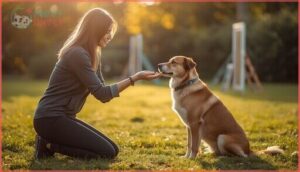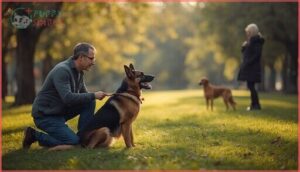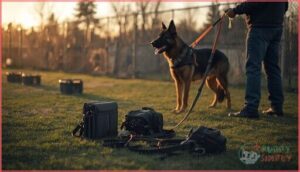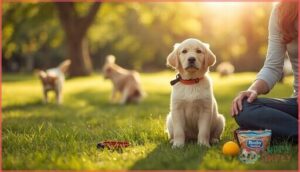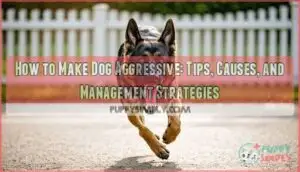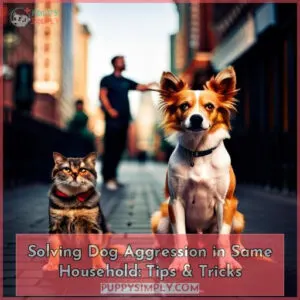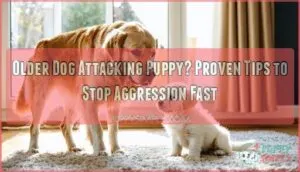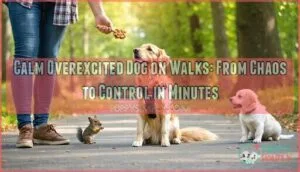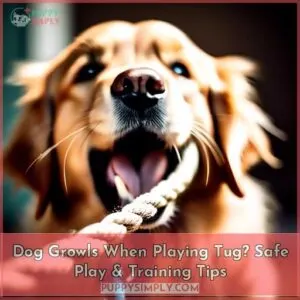This site is supported by our readers. We may earn a commission, at no cost to you, if you purchase through links.
Your dog’s snarl catches you off guard during a routine walk, or maybe they snap when you reach for their food bowl—suddenly, you’re dealing with behavior that feels dangerous and confusing. Dog training aggression issues rank among the most stressful challenges owners face, and they rarely appear without reason.
Behind every aggressive display lies a specific trigger: fear from past trauma, pain from an undiagnosed medical condition, or instincts to guard resources and territory. Understanding what drives your dog’s behavior is the first step toward addressing it safely and effectively.
With the right approach—combining careful assessment, proven behavior modification techniques, and sometimes professional guidance—you can help your dog move past aggression and rebuild the trust between you.
Table Of Contents
- Key Takeaways
- Common Causes of Dog Aggression
- Types of Aggressive Behavior in Dogs
- Recognizing Aggression Warning Signs
- Assessing Your Dog’s Aggressive Tendencies
- Positive Reinforcement Training Methods
- Desensitization and Counterconditioning
- Managing Aggressive Dogs Safely
- Professional Help for Aggression Issues
- Preventing Aggression in Dogs
- Long-Term Maintenance and Relapse Prevention
- Frequently Asked Questions (FAQs)
- Are You dealing with dog aggression?
- How can I handle aggression and agitation in a person with dementia?
- Do dogs have a higher risk of aggression?
- Do dogs have a fear based aggression problem?
- Is it possible to train aggression out of a dog?
- What calms aggression in dogs?
- How to discipline a dog for being aggressive?
- When to put down a dog for aggression?
- How can I address my dogs resource guarding?
- What triggers aggression post-dog attack experiences?
- Conclusion
Key Takeaways
- Every aggressive display stems from a specific trigger—fear, pain, resource guarding, or territorial instincts—and identifying the root cause shapes your entire training approach, making assessment your critical first step.
- Desensitization and counterconditioning form the backbone of effective aggression management by gradually exposing your dog to triggers at tolerable levels while pairing those experiences with rewards, rewiring emotional responses from fear to calm anticipation.
- Prevention through early socialization (weeks 3-14), consistent boundary-setting, and daily mental and physical enrichment stops aggression before it develops, giving dogs the confidence and structure they need to navigate the world without defensive reactions.
- Long-term success requires ongoing maintenance through short daily training sessions, biannual veterinary checks to catch pain or illness early, and a stable home environment with predictable routines that reduce stress-related relapses.
Common Causes of Dog Aggression
Before you can fix aggression, you need to understand what’s driving it—because the root cause shapes everything about your training approach. Dogs don’t act aggressively without reason, and identifying the underlying trigger is the first step toward creating lasting change.
Understanding what drives your dog’s aggression is the first step toward creating lasting change
Let’s look at the most common causes that fuel aggressive behavior in dogs.
Fear and Anxiety Triggers
Fear is often the invisible hand that turns a gentle dog defensive. When your dog faces environmental fears—like thunderstorms triggering noise phobias—or encounters social triggers such as unfamiliar visitors, anxiety can quickly escalate into fear-based aggression.
Separation anxiety and other behavioral issues in dogs create a constant state of tension. Understanding these triggers is your first step toward effective aggression management and helping your aggressive dog feel safe again.
Past Trauma and Negative Experiences
Dogs with a history of abuse, harsh corrections, or repeated negative encounters often carry emotional scars that fuel aggressive responses later. Past trauma rewires how your dog’s brain processes stress—raising baseline anxiety and making ambiguous situations feel dangerous.
These negative experiences can turn an otherwise friendly dog into one who sees threats everywhere, requiring patient trauma recovery through behavior modification and careful trigger management to rebuild trust. Understanding the impact of trauma on canine behavior involves recognizing the importance of scientific study methods in addressing aggression issues.
Territorial and Protective Instincts
While trauma reshapes how your dog interprets the world, another powerful driver of canine aggression emerges from something hardwired: the instinct to claim space and defend what’s yours. Territorial marking and boundary setting aren’t flaws—they’re ancient survival mechanisms that can escalate into territorial aggression without proper trigger management and training.
Key territorial and protective responses in aggressive dogs:
- Alert barking intensifies when unfamiliar visitors approach your home’s perimeter or doorway
- Protective responses spike near family members during perceived threats, often involving lunging or snapping
- Resource guarding overlaps with territorial instincts when food, toys, or spaces become claimed zones
- Stiff posture, raised hackles, and direct stares signal boundary violations before physical contact occurs
- Environmental changes (renovations, new furniture, strangers entering) temporarily heighten territorial reactions
Medical and Genetic Influences
Beyond instinct and environment, your dog’s aggression may have roots you can’t see—hidden in genes or tangled in medical issues. Genetic predisposition influences how individual dogs handle stress, while neurological factors and hormonal imbalance can trigger sudden aggressive behavior.
Chronic pain heightens irritability in any aggressive dog, which is why medical screening matters. Pharmacogenomics research now reveals that certain medications affect canine aggression differently based on your dog’s unique biology.
Types of Aggressive Behavior in Dogs
Not all aggression looks the same—your dog’s behavior tells a story about what’s driving the response, whether it’s fear, frustration, or something else entirely. Understanding the specific type of aggression you’re dealing with helps you choose the right approach to address it safely and effectively.
Let’s break down the four main categories you’ll encounter, starting with the most common triggers and how they show up in your dog’s behavior.
Fear-Based Aggression
When your dog snaps at strangers or lunges away from unfamiliar sounds, you’re likely witnessing fear-based aggression—one of the most common aggression patterns in dogs. This aggressive behavior stems from anxiety responses triggered by perceived threats, where your dog’s instinct is to create distance through intimidation.
Recognizing fear triggers—like cowering, tucked tails, or lip licking before escalation—is essential. Behavior modification for dogs involves trigger desensitization and calming techniques, gradually reshaping your aggressive dog’s emotional response through controlled exposure and positive reinforcement.
Possessive (Resource Guarding) Aggression
Your dog’s snarling over his food bowl reveals possessive aggression—resource guarding that manifests when he perceives threats to valued items like toys, resting spots, or meals. Food aggression and object possession often escalate from stiff postures and staring to snapping if you approach too closely.
Effective aggressive dog training for trigger management focuses on teaching alternative behaviors through controlled access, gradually reducing your dog’s need to defend resources through systematic desensitization.
Territorial and Protective Aggression
Your front door becomes a battleground when territorial aggression drives your dog to guard familiar spaces through barking, stiff posturing, and boundary violations. Protective instincts heighten reactivity near fenced yards and doorways, transforming routine arrivals into high-alert situations requiring immediate aggression management in dogs.
- Environmental modifications like visual barriers reduce territorial marking triggers
- Boundary training establishes clear expectations for acceptable protective behavior
- Controlled exposure to approaching visitors prevents escalation in aggressive dog training
- Trigger management identifies specific territorial aggression cues (footsteps, doorbell sounds)
- Structured socialization reshapes your dog’s perception of territorial intrusions over time
Pain-Induced and Redirected Aggression
Chronic pain from injury or degenerative conditions can transform even gentle dogs into unpredictable biters, lowering pain thresholds until routine touch triggers aggressive responses. Redirected frustration occurs when your dog can’t reach one stimulus (a passing dog outside) and instead lunges at whoever’s nearby, creating dangerous situations requiring immediate behavioral modification and medical interventions.
| Pain-Induced Aggression | Redirected Frustration |
|---|---|
| Sudden onset after movement or touch | Frustration directed at nearby target |
| Localized around affected injury areas | Occurs during barrier-blocked encounters |
| Improves with veterinary pain management | Requires environmental control strategies |
| Warning signs: yelping, withdrawal attempts | Escalates rapidly without clear warning |
Addressing underlying medical causes through veterinary assessment often reduces aggressive dog behavior markedly—transforming dog training outcomes when pain relief accompanies aggression management protocols.
Recognizing Aggression Warning Signs
Reading your dog’s signals before aggression escalates can make all the difference in keeping everyone safe. Dogs rarely bite without warning—they communicate discomfort through subtle (and not-so-subtle) cues that often go unnoticed until it’s too late.
Let’s break down the key warning signs you need to recognize, so you can intervene early and prevent aggressive encounters.
Body Language and Posture
Reading your dog’s signals is like watching a silent conversation unfold—you just need to know the language. Canine posture tells you everything: a stiff body and raised hackles signal an aggressive dog on edge, while pinned ears and a tucked tail reveal stress signals rooted in fear.
Notice facial expressions too—hard stares and tense jaws warn you trouble’s brewing, giving you time to intervene before dog behavior escalates.
Vocalizations and Growling
Growling isn’t just noise—it’s your dog’s clearest warning system, a vocal cue recognition tool you can’t afford to ignore. Understanding growl patterns and canine communication helps you decode threat displays before aggressive behavior erupts:
- Fear-based growls often come with lowered, tucked postures
- Pain-related vocalizations increase when touching sore areas
- Resource-guarding growls occur near valued items
- Playful growling accompanies relaxed body language
These aggression signals demand your attention during dog training with an aggressive dog.
Escalation Patterns and Severity
Once you recognize those growls and stiff postures, watch how quickly things can spiral. Escalation rates vary by aggression triggers—fear-based aggressive behavior can jump from frozen stance to lunging in 5 to 20 seconds.
Severity scales help you gauge risk: early intervention timing (within 3–5 seconds of warning signs) prevents most bites in aggressive dogs, shrinking escalation rates and supporting long-term aggression reduction through careful trigger profile analysis.
Assessing Your Dog’s Aggressive Tendencies
Before you can fix aggressive behavior, you need to understand exactly what you’re dealing with—and that starts with careful observation. Think of this step as building a roadmap: you’ll pinpoint what sets your dog off, gauge how serious the reactions are, and track patterns over time.
Here’s how to assess your dog’s aggression systematically so you can create a training plan that actually works.
Identifying Triggers and Patterns
You can’t fix what you don’t understand—that’s why trigger analysis and pattern recognition are the foundation of behavior modification. Start aggression mapping by observing behavioral chains from first cue to full reaction, then use stress monitoring to track your aggressive dog’s responses.
- Log every incident with date, time, location, and what happened immediately before the dog behavior escalated
- Note body language changes during the 3–5 seconds before aggression in dogs surfaces
- Identify protection behaviors when your dog guards resources like food or toys (these occur in 25–40% of cases)
- Track fear-based patterns including avoidance behaviors and symmetric ear postures that signal rising tension
- Record pain-related triggers especially in older dogs, since untreated discomfort correlates with increased aggression episodes
Severity and Frequency Evaluation
Once you’ve mapped trigger patterns, you need aggression metrics to measure intensity and frequency analysis to track how often incidents occur.
Rate each episode on a 0–3 severity scale (none, mild, moderate, severe) based on intensity and duration, then count weekly occurrences.
This behavior tracking and risk assessment lets you spot improvement—or escalation—in your aggressive dog’s responses.
Keeping a Behavior Log
A written behavior log turns scattered observations into actionable data tracking. Record each incident’s date, time, exact trigger, your dog’s body language, and the intensity on a 0–5 scale—this trigger analysis reveals behavior patterns you’ll miss otherwise.
Review entries weekly with your trainer so behavior modification stays evidence-based, and back up your log to guarantee continuity in dog behavior management.
Positive Reinforcement Training Methods
In addressing aggression, positive reinforcement training is your most powerful tool—and it works by rewarding the behaviors you want to see instead of punishing what you don’t. This approach builds a foundation of trust and cooperation, which is essential when working with an aggressive dog who may already be anxious or fearful.
Below, you’ll find three core methods that form the backbone of positive reinforcement training for aggression issues.
Reward-Based Training Techniques
You’ll see the fastest gains when you pair every correct response with something your dog truly values—treats, toys, or even a quick game. Marker techniques like a clicker signal the exact moment your dog nails the behavior, making positive reinforcement training crystal clear.
Reward systems work because they strengthen desired actions without stress, and calm reinforcement teaches your dog that composure pays off in real, tangible ways.
Building Trust and Confidence
Trust grows through structured experiences that prove you’re consistent and safe—pair gentle exposure to new people or places with praise, and you’ll watch your dog relax within 2–4 weeks. Predictable routines and calm environments form the bedrock of confidence building, especially for an aggressive dog shaped by fear.
- Start trust exercises during early training sessions to boost long-term compliance
- Use positive reinforcement during gradual introductions to unfamiliar settings
- Track progress with behavior logs that capture your dog’s responses across multiple encounters
- Create predictable daily schedules that reduce stress-related behaviors
- Celebrate small wins with your dog to strengthen the bond and build resilience
Reinforcing Calm Behaviors
Consistently catch and reward the exact moment your dog shifts from alert to calm—immediate reinforcement within 1–2 seconds trains self-control far more effectively than delayed praise.
Environmental control (barriers, leashes, consistent routines) prevents over-arousal during early relaxation training, while reward timing transforms calm state management into a reliable skill that reduces aggression through positive reinforcement and behavioral psychology principles.
Desensitization and Counterconditioning
Desensitization and counterconditioning work hand-in-hand to reshape how your dog feels about the things that trigger their aggressive responses. These techniques require patience and careful planning, but they’re among the most effective ways to create lasting behavioral change.
Let’s break down the key components you’ll need to understand and apply throughout this process.
Gradual Exposure to Triggers
Gradual exposure—also called desensitization—means you introduce your dog to triggers at a trigger intensity they can handle without erupting. These desensitization steps form the backbone of behavioral therapy for aggression in dogs, helping foster a calm response through carefully controlled exposure therapy that aids emotional reconditioning.
- Start with stimuli at low intensity—far enough away or quiet enough that your dog notices but doesn’t react aggressively
- Increase exposure levels only after you observe repeatable calm responses across multiple short trials
- Use a structured hierarchy ranking triggers from least to most challenging for systematic progress
- Pair each exposure with positive reinforcement like high-value treats to strengthen training methods for aggressive dogs
- End sessions with a relaxation cue to reinforce safety and consolidate gradual exposure gains
Changing Emotional Responses
Counterconditioning rewires your dog’s emotional response to triggers—transforming fear or frustration into anticipation of rewards through repeated positive associations. When you pair the trigger with high-value treats before aggression surfaces, you’re applying behavioral psychology for dogs to shift neurochemical patterns linked to cortisol and dopamine. This behavioral modification relies on staying below threshold, where emotional regulation remains intact and desensitization techniques can reshape associations.
| Before Counterconditioning | After Counterconditioning |
|---|---|
| Dog sees trigger → feels fear → shows aggression | Dog sees trigger → anticipates reward → remains calm |
| Cortisol spikes, stress escalates | Dopamine increases, positive association forms |
| Avoidance behaviors intensify | Tolerance to trigger improves |
| Emotional arousal remains high | Emotional regulation strengthens |
| Aggression becomes learned response | Positive reinforcement creates new pattern |
Tracking Progress Over Time
Progress metrics reveal whether your dog behavior improvement efforts are working—or stalling. Record weekly data on severity, frequency, and duration using a standardized behavior tracking log, then apply trend analysis to spot meaningful shifts.
Data visualization through simple charts shows plateaus or gains at a glance, while checkpoint evaluation confirms you’re hitting key benchmarks every 4–6 weeks.
This evidence-based approach to dog training aggression issues keeps positive reinforcement and behavioral psychology for dogs grounded in measurable reality.
Managing Aggressive Dogs Safely
When you’re working with an aggressive dog, your first priority is keeping everyone safe—yourself, your dog, and those around you. The right tools and setup can make all the difference between a dangerous situation and a controlled training environment where real progress happens.
Let’s look at the essential equipment and strategies you’ll need to manage aggression safely while you work on behavior modification.
Proper Use of Training Tools (e.g., Prong Collars)
Training tools like prong collars carry serious ethical weight—when you choose to use them, you’re making a decision that directly impacts your dog’s physical and emotional welfare. Dog trainers emphasize Tool Safety Guidelines and Canine Welfare Standards, recognizing that positive reinforcement often provides safer, more effective alternatives. If you do opt for corrective tools during aggression work, follow these Training Tool Ethics principles:
- Use only under certified professional supervision – A qualified dog trainer ensures proper fit, timing, and Effective Leash Handling techniques that prevent injury or fear escalation.
- Fit the prong collar high on the neck – Incorrect placement can crush the trachea or damage delicate structures, so positioning matters enormously for safety.
- Apply gentle, communicative pressure—never jerking or yanking – The goal is redirection, not punishment; harsh corrections often worsen aggression by increasing fear and stress.
- Limit use to the shortest duration possible – Prolonged reliance can create chronic anxiety, so shift to Prong Collar Alternatives like front-clip harnesses as soon as progress allows.
- Pair with positive reinforcement and desensitization – Reward calm behavior near triggers to build new emotional responses, ensuring the tool assists—rather than replaces—humane Training Techniques.
Remember, every dog deserves training that prioritizes their dignity and trust.
Muzzle Training and Safety Equipment
Beyond collars, muzzle introduction becomes your safety net—think of it as giving your dog (and everyone around them) breathing room during Behavior Modification. Start with a basket-style muzzle (Equipment Selection that allows panting), pair it with high-value treats, and practice brief sessions at home.
Proper Safety Protocols mean your Aggressive Dog Training never puts anyone at risk, while positive reinforcement keeps the experience calm and trust-building.
Creating Controlled Environments
Once your dog’s safely muzzled, Environment Design matters just as much as the gear itself—picture setting the stage where Trigger Management happens without surprises. Controlled Spaces give you predictability (distance control, escape routes, minimal distractions), which makes Gradual Exposure work. For effective Safety Protocols and Canine Behavior Modification:
- Choose quiet locations with minimal foot traffic
- Control distance between your dog and triggers systematically
- Use barriers like fences or cars for added security
- Document each session’s environmental variables
- Build consistent routines in familiar training spots
This groundwork turns chaotic reactions into manageable Aggression Training sessions, reinforcing Positive Reinforcement and sustainable behavior change through thoughtful preparation.
Professional Help for Aggression Issues
Sometimes aggression runs deeper than what you can tackle on your own—and that’s when bringing in the right professionals makes all the difference. Knowing who to call (and when) can transform your dog’s behavior and your peace of mind.
Whether you need a certified trainer to guide your approach, a vet to rule out pain or illness, or a specialized program for severe cases, let’s break down the key resources that can help you and your dog get back on track.
When to Consult a Certified Trainer
If your dog’s aggression persists despite weeks of consistent management, it’s time to bring in a Certified Professional Dog Trainer. Professional Guidance becomes essential when aggression escalates across multiple triggers, involves bite threats, or continues after ruling out medical causes.
A qualified Dog Trainer specializing in Behavior Modification and Aggression Assessment will create targeted interventions—Trainer Selection matters when safety hangs in the balance.
Veterinary Assessments for Medical Causes
Before assuming your dog’s aggressive behavior stems from temperament alone, rule out pain, illness, or hormonal imbalances through a complete Veterinary Evaluation. Medical Tests pinpoint systemic causes of Dog Aggression, while Pain Assessment and Neurological Exam detect discomfort or brain abnormalities driving Aggressive Behavior.
- Complete blood count and thyroid panels reveal endocrine disorders linked to irritability
- Pain Assessment scales correlate physical discomfort with aggression triggers
- Diagnostic Imaging (X-rays, MRI) identifies hidden injuries or neurological issues
Veterinary professionals specializing in Animal Behavior and Psychology collaborate with trainers to distinguish medical from purely behavioral causes.
Specialized Behavior Modification Programs
When standard approaches fall short, extensive behavior modification programs step in—combining veterinary medical assessments with evidence-based training protocols customized to your dog’s specific aggression profile.
These canine rehabilitation programs use structured desensitization, counterconditioning, and positive reinforcement techniques under close professional supervision, tracking progress through standardized behavioral assessments and ongoing program evaluation to guarantee safety and measurable improvement.
Preventing Aggression in Dogs
The best way to handle aggression is to stop it before it starts—and that begins with how you raise and manage your dog from day one. Prevention isn’t about one magic trick; it’s a combination of early experiences, clear expectations, and keeping your dog’s mind and body engaged.
Let’s break down the three pillars that set dogs up for calm, confident behavior throughout their lives.
Early Socialization Techniques
The first three to fourteen weeks of a puppy’s life serve as the foundation for preventing social aggression in dogs—miss this critical window, and you’re fighting an uphill battle. Proper puppy socialization and environmental exposure during this period use habituation methods and positive reinforcement to reduce fear and build confidence in dog training and socialization.
- Introduce puppies to diverse people, dogs, and environments through short, controlled sessions
- Use calming techniques and high-value rewards to pair new experiences with positive outcomes
- Expose pups gradually to household sounds, textures, and novel objects for fear reduction
- Monitor stress signals carefully, adjusting pace to prevent overwhelming your dog
- Document responses and progress to tailor your dog socialization approach effectively
Consistent Training and Boundaries
Setting boundaries isn’t just about saying “no”—it’s about building a language your dog can trust. Clear communication through training consistency prevents the confusion that often sparks aggression, especially when paired with positive reinforcement and reward systems that highlight desired behaviors.
Consistent training techniques create the predictable structure dogs need for canine socialization success. When you enforce boundaries uniformly—no jumping today means no jumping tomorrow—you’re giving your dog the roadmap to navigate the world without resorting to defensive aggression. That predictability becomes the foundation for dog training and behavior modification that lasts.
| Boundary Setting Element | Implementation Strategy |
|---|---|
| Training Consistency | Apply identical rules across all family members and settings |
| Reward Systems | Deliver immediate, predictable reinforcement for calm responses |
| Environment Control | Use management tools (leashes, barriers) to support learning |
| Clear Communication | Define specific, observable behaviors rather than vague expectations |
Mental and Physical Enrichment
Think of enrichment as preventive medicine for aggression in dogs—when your dog’s mind and body get the workout they need, stress-related behavioral issues rarely take root. Cognitive stimulation through sensory play and environmental enrichment builds emotional wellbeing while channeling energy away from reactive behaviors, addressing dog psychology fundamentally.
- Rotate puzzle feeders weekly to maintain novelty and boost problem-solving engagement by 20–40%
- Schedule 60-minute daily play sessions combining canine fitness with positive reinforcement training cues
- Layer scent work, chew toys, and interactive games for multimodal stress reduction
- Track your dog’s response patterns to identify which enrichment activities best support canine behavior stability
Long-Term Maintenance and Relapse Prevention
Managing your dog’s aggression isn’t a one-and-done process—it requires ongoing commitment to keep progress intact and prevent setbacks. Just like any behavioral change, aggression management can fade without consistent reinforcement, regular monitoring of your dog’s health, and a stable home environment.
Here are the key elements you’ll need to maintain long-term success and reduce the risk of relapse.
Ongoing Training and Reinforcement
Training your aggressive dog isn’t a finish line—it’s more like tending a garden that needs regular care. Short, daily sessions of 5–10 minutes using positive reinforcement and reward-based training maintain progress far better than sporadic work.
Variable reinforcement schedules strengthen obedience training across contexts, ensuring behavior generalization. Consistency across all household members prevents confusion, while maintenance strategies like booster sessions guard against relapse.
Regular Health Checks
Beyond behavior work, your dog’s physical health directly influences aggression in dogs—pain, thyroid imbalances, and dental disease can all trigger irritability. Schedule veterinary exams twice yearly for senior dogs (annually for adults) to catch issues early through bloodwork and preventive medicine.
Your wellness checklist includes:
- Vaccine schedules and parasite control updates
- Dental care assessments to prevent chronic pain
- Baseline thyroid and organ function tests
- Nutritional advice customized to your dog’s needs
- Weight monitoring as part of thorough pet care and wellness
Catching medical triggers protects both dog safety and prevention efforts.
Creating a Supportive Home Environment
Medical checks lay the foundation—but your home’s daily atmosphere shapes whether aggression stays managed. Routine Consistency anchors your dog’s sense of security; predictable mealtimes, walks, and rest prevent stress-related flare-ups.
Calming Spaces with enrichment toys let him self-regulate arousal, while Household Harmony ensures everyone enforces the same boundaries.
Environmental Enrichment plus unified Leadership and Structure give Dog Owners sustainable Stress Reduction and lasting Dog Safety and Prevention.
Frequently Asked Questions (FAQs)
Are You dealing with dog aggression?
Your dog’s growling or snapping mightn’t be “aggression” at all—it could be fear or frustration.
A trained professional can assess whether the behavior meets clinical aggression criteria and recommend safe next steps.
How can I handle aggression and agitation in a person with dementia?
Aggression and agitation in dementia care stem from unmet needs—pain, overstimulation, or confusion.
Use calming techniques like validation, gentle redirection, and consistent routines while maintaining safety protocols throughout each interaction.
Do dogs have a higher risk of aggression?
Like a Victorian-era guard dog bred for a single purpose, some canines carry genetic breed predisposition and environmental influences that increase aggression risk.
Though canine temperament, socialization, and management strategies determine whether fear-based aggression or social aggression actually emerges.
Do dogs have a fear based aggression problem?
Yes, fear-based aggression is extremely common in dogs—accounting for a substantial portion of reported canine anxiety and aggressive behavior cases. These behaviors are often triggered by unfamiliar situations, sudden movements, or past trauma, requiring behavioral therapy.
Is it possible to train aggression out of a dog?
Training can markedly reduce aggressive behavior in dogs through behavioral modification and aggression therapy, though complete elimination isn’t guaranteed.
Success depends on the aggression’s root cause, consistency in canine behavior rehabilitation, and professional guidance for lasting training outcomes.
What calms aggression in dogs?
You can calm aggressive behavior through environmental management—consistent routines, quiet safe spaces—paired with positive reinforcement training, reward-based conditioning, scent therapy, and relaxation techniques that address fear-based aggression at its emotional roots.
How to discipline a dog for being aggressive?
Paws for thought: traditional “discipline” backfires with aggressive behavior. Instead, you’ll address aggression triggers through behavior modification—rewarding calm responses, gradually desensitizing to stressors, and implementing safety measures like muzzles during controlled training sessions.
When to put down a dog for aggression?
Euthanasia becomes a last-resort consideration only after thorough aggression assessment shows consistent failure of behavior modification, when risk evaluation confirms unmanageable danger to people, and quality life for your dog can’t be maintained humanely.
How can I address my dogs resource guarding?
You can address resource guarding through desensitization techniques and trigger mapping. Practice hand feeding and trade low-value items, while pairing your presence with positive outcomes.
Establish safety protocols to prevent possessive aggression escalation.
What triggers aggression post-dog attack experiences?
Post-trauma stress from dog attacks can trigger fear-based aggression through associative learning—your dog may now perceive similar breeds, environments, or handling as threats, lowering aggression thresholds and intensifying fear responses.
Conclusion
Like untangling a knot that only tightens when you pull harder, resolving dog training aggression issues requires patience, precision, and a willingness to work with—not against—your dog’s instincts.
You’ve now got the framework to identify triggers, implement behavior modification techniques, and know when professional guidance becomes essential.
The path forward isn’t always quick, but every small victory rebuilds the bond you thought aggression might’ve broken forever.
- https://www.sciencedirect.com/science/article/abs/pii/S0168159108001147
- https://bmcgenomics.biomedcentral.com/articles/10.1186/s12864-016-2936-3
- https://www.pumpkin.care/blog/dog-aggression-training/
- https://www.michaelsdogs.com/2022/03/09/positive-reinforcement-and-aggressive-dog-training/
- http://www.wikihow.com/Crate-Train-Your-Dog-or-Puppy


